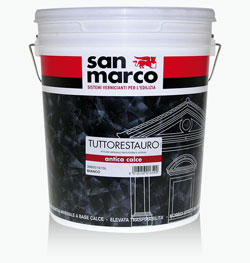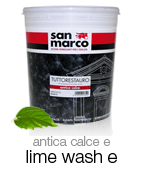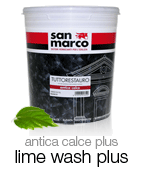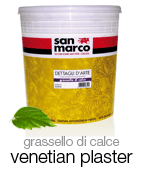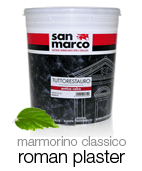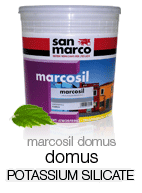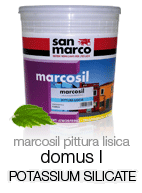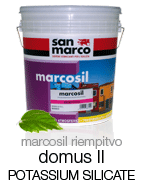LIME WASH
LIME WASH PAINT (ANTICA CALCE) / SERIES 398
Based on a natural mineral binder, suitable for outdoor/indoor wall surfaces, it creates the typical decorative effect of antique lime-based decorations, with shaded color effects. Especially suitable for restoration projects, including buildings of historical-artistic interest. Must be applied to damp surfaces. Applied by brush only. High breathability, absorbs toxins, prohibits bacteria that forms mold.
Mineral based paint for outdoor and indoor use.
SUPERIOR SUBSTITUTE FOR LATEX PAINT
- Indicative Spreading Rate: 1,000 – 1,500 Square Feet With 1 Coat
- Number of Coats: 1 – 3
- Tools: Brush
- Dilution: With Water
- Base Coat: 50% – 250%
- Subsequent Coats: 50% – 90%
- VOC: 0% - 1.78% With Maximum Colorant Added
PORTFOLIO
Approved as an Eco construction material in Europe with optimum breathability 90% – 95%, prohibits mold forming bacteria, 0% – 1.85% VOC (<30g/lt).
Antica Calce Lime Wash Paint can be identified in Roman construction and its use is clearly visible in the Pompeii and Herculean ruins in Southern Italy. This was the only interior/exterior paint available for painted surfaces, other than fresco or marmorino plaster tinted with earth pigments. The use of this material disappeared after the fall of the Roman Empire and did not resurface until the late middle ages when European civilization began to flourish after the Dark Ages. Lime Wash Paint reached its zenith during the Renaissance and continued as the masonry paint of choice until after WWI, then almost disappearing from production by the late 1950s. The rare instances where Lime Wash continued was for Italian State Historical Buildings until the advent of the “Green” movement for biological and ecological building materials that began to appear in Italy in the late 1990s.
Lime products such as Antica Calce (lime wash paint), Marmorino (Italian Marble Plaster), Grassello di Calce (Venetian Plaster), Intonachino Minerale (Lime cement) and any other Italian lime based products are produced from sedimentary rock rich in carbonated lime (CaCO3) and extracted from quarries in the Dolomites. They can also can be produced from marble (henceforth the principal reason marble was extracted from the roman ruins in the Middle Ages). The sedimentary rock is crushed and then placed into ovens that are heated to about 800°C – 1,200°C for 1 to 2 days. In this phase a reaction occurs and liberates andride carbonic, reducing the weight of the stone by a 1/3rd as a result of the loss of carbon and oxygen. This is called Active Lime, and for the final phase of this material to be used in plaster and paint, it must be deposited in pools where water can be added slowly over a 2 year time period, wherein intense heat is generated,, and the Active Lime becomes Inactive Lime (Slaked Lime).
The phenomena of this carbonization is that when Inactive Lime is mixed with inert materials, such as other lime, sand, marble dust, and water, and is applied to a surface and then the mixture becomes in contact with air (CO2) and dries, it returns to the same identical rock from which the lime was formed, although in crystalline particles far smaller than the original stone. Lime based products made from this process can endure for centuries and is a non polluting for the environment.
This is the base for Ecological Cement or Green Cement which is non Portland based and was the building element essential in Roman construction and is why Roman buildings such as the Pantheon are still in sound structural condition. Lime based products such as Calce (Lime) Cement takes approximately 1,000 years to reach maximum calcification and is 4 times more elastic than Portland Cement.
Material Composition:
Slaked Lime, Dolomite lime, a small amount of binding resin, and water. Paint color is created by the use of natural earth minerals concentrated, a small amount of binding resin, and water.
Color Choices:
A brochure can be supplied with your paint samples to give you an indication of historical colors used with this product. A paint color fan can be provided to offer the maximum ranges of colors that can also be used with Antica Calce. Color values need to be in the range of medium to light pastels. Very dark colors are not recommended or are impossible to produce.
Tints:
Color tint concentrates offer the possibility to adjust color ranges to suit your needs. Use very small quantities of concentrate to adjust color.
Antique Effects for Stucco and Brick:
Italian Lime Wash can be diluted to very small percentages, as little as 1/9 parts to create a hint of color on stuccos and brick (on pre-coloured stucco or over full concentration of lime washed stucco) to create an effect of a colored wash that appears to be centuries old.
Training and Certification:
San Marco provides training and the technical use of these products for professionals who wish to use these products for Antica Calce (Lime Wash), Marmorino (Italian Marble Plaster), and Grassello di Calce (Venetian Plaster).
